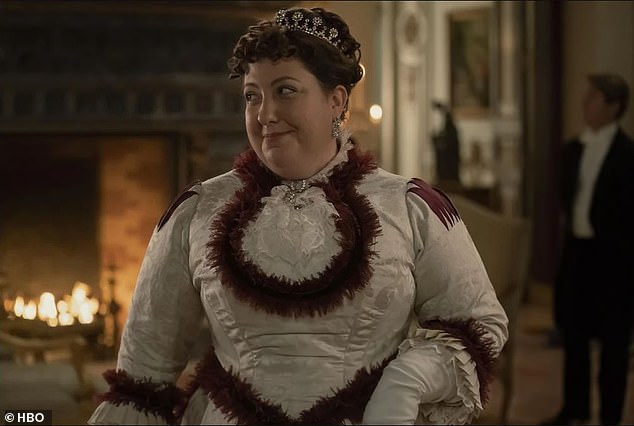Mamie Fish was no great beauty. Nor was she especially rich or well educated.
But what she may have lacked in money and looks, she made up for in creativity. She was also very funny – despite what the many photographs showing her scowling grimly into the camera may suggest.
And it was these talents that helped secure her place as the life and soul – literally – of New York’s Gilded Age party scene.
Mamie’s invitations were the hottest tickets in town – and everyone from the old money Astors and Vanderbilts to celebrities like Oscar Wilde and Sarah Bernhardt clamored to be a part of these legendary, no-expense-spared events, even if that meant dodging lightbulbs thrown by an intoxicated chimp.
Mamie – played by the actor Ashlie Atkinson in HBO’s The Gilded Age, season 3 of which starts on June 22 – also benefited from that rare thing in the late-19th century: a marriage of love. And her super-rich husband would do anything to keep her happy.
Mamie – Marion Graves Anthon – was born in 1853 to a well-to-do New York family, but, when she was 22, her father died, forcing them to move out of their elegant Manhattan home.

Mamie – played by the actor Ashlie Atkinson in HBO ‘s The Gilded Age – benefited from that rare thing in the late-19th century: a marriage of love

Actress Carrie Coon is seen above in HVO’s gilded age

Her initial soirees displeased societal arbiters like Ward McAllister, the man played by Nathan Lane in the HBO series (right)
They relocated to Astoria, Queens, a place, at the time, known mostly for petroleum factories and the accompanying putrid smell – sometimes likened to ‘a wall of sewage.’
To help her family rise out of these reduced circumstances, Mamie was going to have to marry very well, though not everyone had high hopes.
Fortunately, however, she caught the eye of one Stuyvesant Fish, a childhood friend born ‘with a silver spoon in his mouth big enough to be called a soup ladle.’ Fish was besotted with her – and she flirted right back.
After one night out, she wrote to inform him that he’d forgotten to send her flowers in the morning. But, not to worry, a friend of his had.
He never forgot again, and the pair soon married.
Stuyvesant absolutely adored his funny bride, and one friend of the couple, the heiress and social commentator Elizabeth Drexel, claimed he was like a knight ‘who would ride into battle at her lightest word.’
Once, when he saw her coughing on a veranda, he asked if he could bring her something for her throat. She suggested a diamond necklace.
But not everyone loved Mamie’s insouciance, or her tendency to complain loudly about the era’s refined entertainment.

Season 3 of HBO’s The Gilded Age starts on June 22


Mamie (left) was known to be very funny – despite what the many photographs showing her scowling grimly into the camera may suggest; Stuyvesant Fish (right) was besotted with her

Before long, she had bought a house in Newport, where she resolved to throw the wildest, most unique parties America had ever seen
She complained that the long operas society loved attending ‘surpassed everything I ever knew in the line of boredom.’ Instead, she preferred the more riotous hijinks of PT Barnum’s circus – and they inspired her to throw extravagant parties of her own.
Her initial soirees displeased societal arbiters like Ward McAllister, the man played by Nathan Lane in the HBO series, who compiled the list of ‘the 400’ most influential people in New York society.
McAllister was especially horrified by one of her early efforts, ‘a duck pond dinner’ during which she set up a large tub of water in the middle of the dining table – so ducks were not merely served, but could also be seen frolicking, very much alive, in front of guests.
McAllister believed a proper dining table was one that contained no more than one bundle of flowers, and he was so horrified by her excess that he ‘read Mamie out of society’ – informing other hostesses that she was hopelessly vulgar.
Undeterred, Mamie defied her nemesis, according to the Dixon Evening telegraph, and ‘plunged right into the middle of society.’
Before long, she had bought a house in Newport, where she resolved to throw the wildest, most unique parties America had ever seen.
The US, historically, had not been a country known for its parties. You can partly blame the Puritans for that. But, more importantly, you can blame the sheer size of the country. Most early Americans lived in rural areas where they were physically distanced from their neighbors – making traveling to other people’s houses to socialize difficult.
However, while 94 percent of Americans lived in the countryside at the beginning of the 19th century, by the end of it, a full 40 percent lived in cities. Going to multiple parties in a single week no longer seemed impossible; indeed, in a time before a lot of in-home entertainment, it seemed extremely desirable.

Mamie’s invitations were the hottest tickets in town (Mamie is pictured far right)


Jennifer Wright’s new book is published August 5

Mamie complained that the long operas society loved attending ‘surpassed everything I ever knew in the line of boredom’
But the parties most people – even the extremely wealthy – were going to were not exciting. One woman, describing one of the illustrious Mrs Astor’s soirees, claimed: ‘I was bored to death. I amused myself by grading the people at the table in terms of dullness from one to ten, with one being the absolute peak of deadliness – and hardly a guest fell above three.’
Mamie set about remedying this. Rather than the multi-hour dinners guests had become accustomed to, she resolved to keep dinner to an hour. And was determined to provide amusement beyond the conversation of fellow diners.
To begin with, however, she may have made things a bit too fast-paced. At one eight-course extravaganza served in half an hour, guests were seen frantically clutching their plates to keep the staff from removing them nearly as soon as they’d set them on the table.
The Pittsburgh Press declared: ‘Mrs Astor was dignified. Mrs Fish was flip. Mrs Astor gave conventional balls. Mrs Fish staged unconventional routs.’
One of those included her famed Dog’s Dinner. After one man told Mamie he thought women were now more fond of dogs than men, she told him she’d rearrange her dinners accordingly.
Women were invited along with their pups – and the dogs were dressed in their finery for the occasion, with Mamie’s own dog wearing a diamond collar.
The dinner was no less refined than it would have been for humans, with candelabras and butlers, and on the menu a sophisticated feast of rice, stewed liver, fricassee and dog biscuits.
One dog was so well fed he passed out on his plate and had to be carried home in his owner’s arms.
He may have missed the highlight of the evening – which was the provision of cats for the canine guests to chase at will.
And this was hardly the only animal-centric party Mamie would become known for. Her most famous was perhaps the one thrown to honor one Prince Del Drago in 1902.
This came at the height of her Newport neighbors’ obsession with aristocracy. Wealthy mothers were hoping to use their new American fortunes to marry their daughters off to more or less any European with a title, and one song of the day declared: ‘The almighty dollar will buy, you bet/A superior class of coronet.’
So, when Mamie threw a party for the Prince Del Drago, all of Newport society was clamoring to attend. Only when they got there did they discover their eligible prince was actually a monkey. He wore a tiny dinner jacket.

Mamie’s Rhode Island home was the venue for some of her wildest parties

Only when they got there did they discover their eligible prince was actually a monkey. He wore a tiny dinner jacket. (Pictured: A file photo of a monkey dressed for dinner)
The monkey behaved surprisingly well, even eating with a fork and knife, and, in the words of Elizabeth Drexel: ‘His manners compared favorably with some princes I have met.’
However, his good behavior soon took a turn for the worse when someone let him have champagne, at which point he began swinging from the chandelier, grabbing lightbulbs and flinging them at guests.
Most seemed to agree that it was still much more fun than dinners with an actual aristocrat.
Mamie also hosted a Valentine’s ball, where children dressed as Cupid ran about the party delivering notes written from guests to one another. If they grew bored of sending love notes, they could watch a troupe of ballerinas Mamie brought in, ‘their skirts were illuminated with tiny electric lights.’
Another party was her Mardi Gras Ball, which featured a ‘Satanic Flower Garden.’ There, all the flowers were designed to resemble fire, and guests were given pitchforks as party favors.
At her annual Harvest Ball, guests were required to dress as farmers, and ate on long wooden tables, while Mamie’s home was decorated with scarecrows, haybales and thousands of sunflowers.
Then there was the Reversible Dance, when everyone in attendance had to wear their clothing back to front. She declared that ‘people should look as if their heads were on the wrong way round’.
To celebrate her new home, she turned the house into a vaudeville theater. A play was performed in which – hundreds of years before Comedy Central Roast – guests were gently mocked.
Afterwards, they watched a dancing pony, trained dogs, clowns, and acrobats. There was even an elephant in attendance.
It was parties like this that ensured that Mamie was known, long into this century, as a hostess who brought not only elegance, but verve and humor to America’s party culture.
So, next time you go to a themed party, don’t forget you have Mamie Fish to thank.
Glitz, Glam, and a Damn Good Time by Jennifer Wright is published by Grand Central Publishing, August 5








